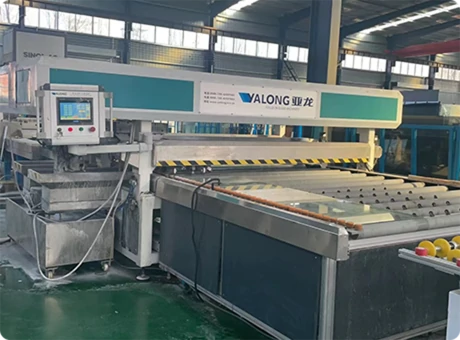The Process and Benefits of Tempered Glass Manufacturing
Tempered glass manufacturing has become a significant sector within the glass industry, owing to its remarkable strength and safety features. This article explores the processes involved in manufacturing tempered glass, its applications, and the benefits it offers to various industries.
Understanding Tempered Glass
Tempered glass, also known as toughened glass, is produced through a special thermal treatment process that enhances its strength compared to regular glass. By subjecting the glass to high temperatures—typically around 620 to 700 degrees Celsius—followed by rapid cooling, the internal stresses of the glass are altered. This method increases its resistance to impact and thermal shock, making tempered glass a preferred choice for many applications.
The Manufacturing Process
The production of tempered glass involves several key steps
1. Cutting and Preparation The process begins with cutting standard glass sheets to the desired dimensions. The quality of the raw glass is paramount, as any imperfections can affect the final product. The edges of the glass may be polished to ensure safety and improve aesthetics.
2. Cleaning Before the glass is heated, it must be thoroughly cleaned to remove any dust, debris, or contaminants. Even minor impurities can lead to defects during the tempering process, so this step is crucial.
3. Heating Once cleaned, the glass is transferred to a tempering furnace where it is heated uniformly. This stage can take approximately 15 to 20 minutes. The goal is to reach the required temperature evenly to promote uniform strength across the entire sheet.
4. Quenching After reaching the peak temperature, the glass is rapidly cooled using high-velocity air jets. This quenching process is essential as it solidifies the outer layers of the glass while keeping the interior at a higher temperature. The differential cooling creates compressive stresses on the surface while maintaining tensile stresses within, resulting in a strong finished product.
5. Inspection and Quality Control After tempering, each sheet undergoes rigorous inspection to identify any defects. Automated systems may be used to assess the optical clarity and structural integrity of the glass. Each tempered glass sheet must meet strict safety standards, ensuring they are free from flaws that could compromise performance.
6. Finishing Finally, the tempered glass may undergo additional finishing processes, such as cutting, drilling, or lamination, depending on the intended application.
Applications of Tempered Glass
tempered glass manufacturing plant
Tempered glass is widely utilized in various industries due to its strength and safety characteristics. Common applications include
- Architecture and Construction Tempered glass is extensively used in building facades, windows, balustrades, and shower doors
. Its ability to withstand high winds and impact makes it ideal for high-rise buildings and public spaces.
- Automotive Many vehicle manufacturers prefer tempered glass for side and rear windows due to its safety features. In the event of an accident, tempered glass shatters into small, blunt pieces, reducing the risk of injury.
- Household Items Products such as tabletop surfaces, kitchenware, and glass doors often feature tempered glass to enhance safety and durability.
- Electronics The screens of smartphones, tablets, and other electronic devices frequently utilize tempered glass to protect against scratches and impacts.
Benefits of Tempered Glass
The advantages of using tempered glass are numerous
1. Safety Tempered glass is much safer than untreated glass. In the event of breakage, it shatters into small pieces, significantly reducing the risk of injury.
2. Strength The tempering process increases the glass's overall strength, making it five to six times stronger than standard glass of the same thickness.
3. Thermal Resistance Tempered glass can withstand extreme temperature fluctuations, making it suitable for environments with high heat or sudden temperature changes.
4. Versatility With its broad range of applications, tempered glass can be found in diverse settings, combining functionality with aesthetic appeal.
In conclusion, tempered glass manufacturing involves a sophisticated process that enhances the glass's safety and strength, making it an indispensable material in modern architecture, automotive design, and consumer products. As technology advances, the demand for tempered glass is likely to grow, further integrating it into various facets of daily life.
 Afrikaans
Afrikaans  Albanian
Albanian  Amharic
Amharic  Arabic
Arabic  Armenian
Armenian  Azerbaijani
Azerbaijani  Basque
Basque  Belarusian
Belarusian  Bengali
Bengali  Bosnian
Bosnian  Bulgarian
Bulgarian  Catalan
Catalan  Cebuano
Cebuano  Corsican
Corsican  Croatian
Croatian  Czech
Czech  Danish
Danish  Dutch
Dutch  English
English  Esperanto
Esperanto  Estonian
Estonian  Finnish
Finnish  French
French  Frisian
Frisian  Galician
Galician  Georgian
Georgian  German
German  Greek
Greek  Gujarati
Gujarati  Haitian Creole
Haitian Creole  hausa
hausa  hawaiian
hawaiian  Hebrew
Hebrew  Hindi
Hindi  Miao
Miao  Hungarian
Hungarian  Icelandic
Icelandic  igbo
igbo  Indonesian
Indonesian  irish
irish  Italian
Italian  Japanese
Japanese  Javanese
Javanese  Kannada
Kannada  kazakh
kazakh  Khmer
Khmer  Rwandese
Rwandese  Korean
Korean  Kurdish
Kurdish  Kyrgyz
Kyrgyz  Lao
Lao  Latin
Latin  Latvian
Latvian  Lithuanian
Lithuanian  Luxembourgish
Luxembourgish  Macedonian
Macedonian  Malgashi
Malgashi  Malay
Malay  Malayalam
Malayalam  Maltese
Maltese  Maori
Maori  Marathi
Marathi  Mongolian
Mongolian  Myanmar
Myanmar  Nepali
Nepali  Norwegian
Norwegian  Norwegian
Norwegian  Occitan
Occitan  Pashto
Pashto  Persian
Persian  Polish
Polish  Portuguese
Portuguese  Punjabi
Punjabi  Romanian
Romanian  Russian
Russian  Samoan
Samoan  Scottish Gaelic
Scottish Gaelic  Serbian
Serbian  Sesotho
Sesotho  Shona
Shona  Sindhi
Sindhi  Sinhala
Sinhala  Slovak
Slovak  Slovenian
Slovenian  Somali
Somali  Spanish
Spanish  Sundanese
Sundanese  Swahili
Swahili  Swedish
Swedish  Tagalog
Tagalog  Tajik
Tajik  Tamil
Tamil  Tatar
Tatar  Telugu
Telugu  Thai
Thai  Turkish
Turkish  Turkmen
Turkmen  Ukrainian
Ukrainian  Urdu
Urdu  Uighur
Uighur  Uzbek
Uzbek  Vietnamese
Vietnamese  Welsh
Welsh  Bantu
Bantu  Yiddish
Yiddish  Yoruba
Yoruba  Zulu
Zulu 

